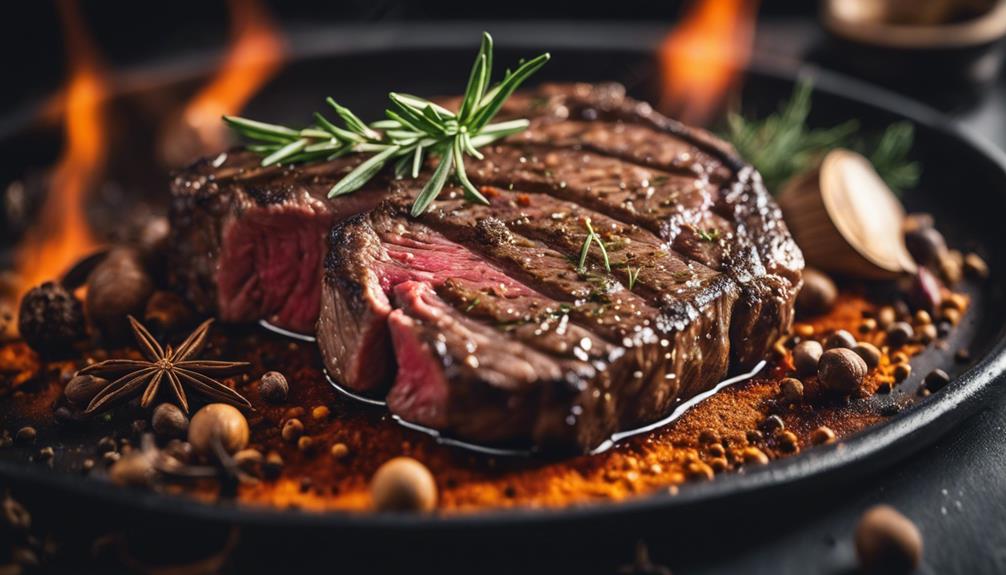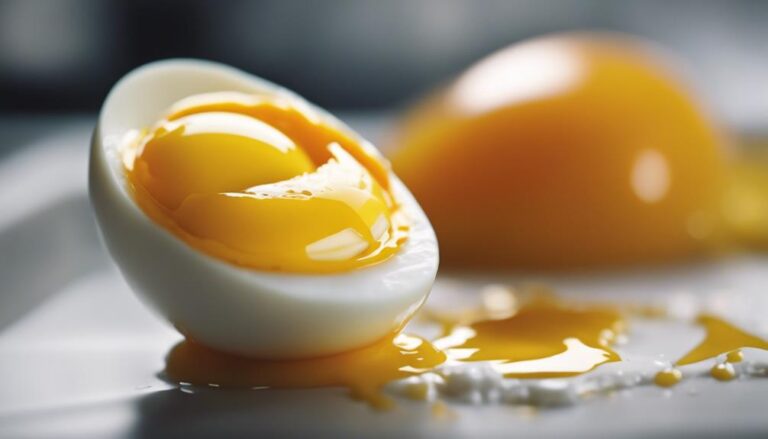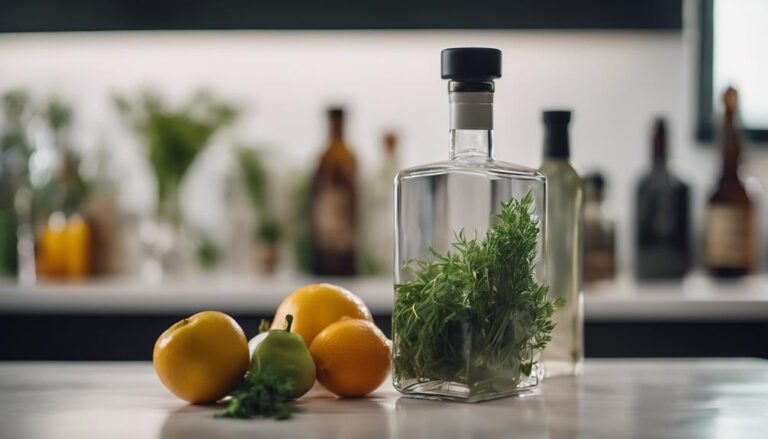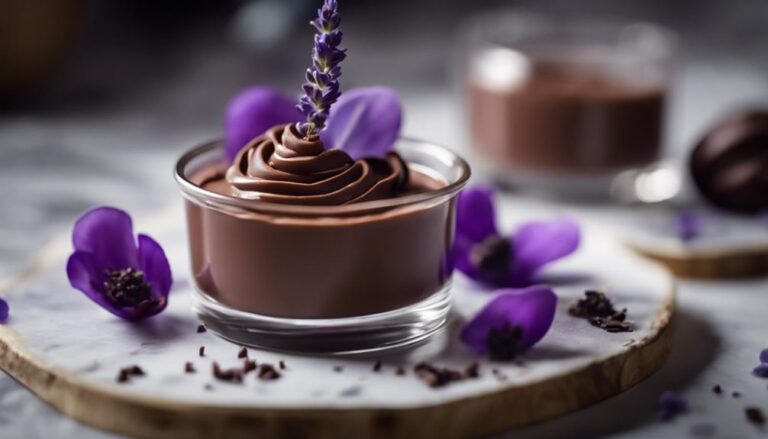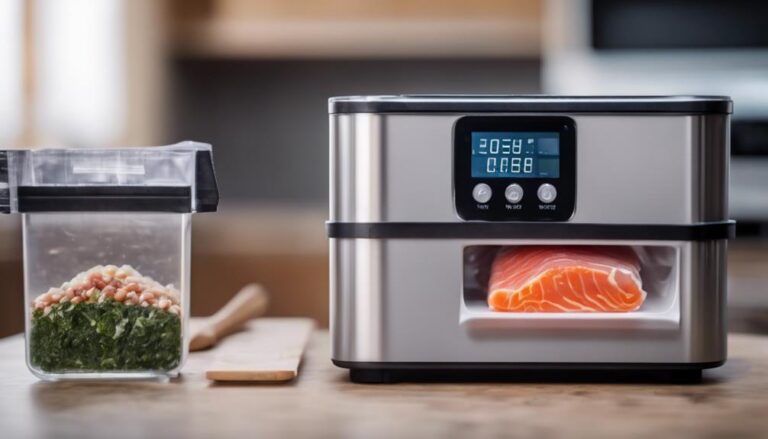To Sear or Not to Sear: The Sous Vide Question
When cooking sous vide, searing can enhance flavor and texture. It's a choice to elevate your dishes. Some love a crispy crust. Pros swear by searing. Your choice impacts the outcome. If you want to learn more about perfecting your sous vide technique, you might uncover some searing secrets.
What You Will Learn Here
- Searing enhances flavor, texture, and aroma in sous vide dishes.
- Searing creates a crispy exterior and seals in juices for moist meat.
- Experiment with pre-searing and post-searing techniques for optimal results.
- Professional chefs recommend searing for elevated taste experiences.
- Searing is a choice based on desired outcome, balancing personal preference and necessity.
Benefits of Searing in Sous Vide
When using sous vide, searing your food after cooking can greatly enhance the overall flavor and texture of your dishes. Searing plays an important role in creating a delightful contrast between the crispy exterior and tender interior of your meal, making each bite a symphony of textures. The Maillard reaction that occurs during searing not only improves the appearance of the dish but also deepens the flavor profile, giving it a rich and savory taste that's sure to impress your guests.
Moreover, searing helps seal in the juices and retain moisture within the food, ensuring that every morsel is succulent and bursting with flavor. The enhanced aroma and visual appeal of a well-seared dish engage all the senses, elevating the dining experience to new heights. So, next time you finish your sous vide cooking, don't forget the searing step – it's the secret ingredient that enhances your culinary creations to perfection.
Searing Techniques for Sous Vide
Enhance the flavor and texture of your sous vide dishes by mastering effective searing techniques. When it comes to sous vide searing, there are a few key points to keep in mind:
- Use the Right Tools: Whether it's a cast-iron pan, a blow torch, or a Searzall attachment, having the right tool can make all the difference in achieving that perfect caramelized crust through the Maillard reaction.
- Prepare Your Meat Properly: Before searing, make sure to completely dry your meat to guarantee a crispy brown crust forms. Additionally, seasoning the meat before searing not only adds flavor but also helps develop a visually appealing crust.
- Heat Things Up: Properly heat your pan until very hot before adding oil and the meat. This step is essential for achieving a good sear and locking in flavor while creating that delicious caramelized crust that enhances the overall flavor of your dish.
Pre-Searing Vs. Post-Searing

When deciding whether to pre-sear or post-sear in sous vide cooking, timing plays an essential role in flavor development and texture enhancement. Pre-searing jump-starts the Maillard reaction for deeper flavors, while post-searing adds that final touch of taste and texture.
The choice between pre-searing and post-searing ultimately depends on achieving the desired flavor impact and overall cooking outcome.
Timing of Searing
For peak flavor and texture in sous vide cooking, consider both pre-searing and post-searing techniques to enhance your dishes. Here are three key points to keep in mind:
- Jump-start Crust Development: Pre-searing can kickstart crust development and enhance Maillard flavors in your sous vide dishes.
- Reduce Cooking Time: Some argue that pre-searing not only enhances flavors but also reduces the time needed for a final sear, making your cooking process more efficient.
- Evenly Cooked Results: Pre-searing helps minimize the temperature gradient in meat, resulting in a more evenly cooked dish with ideal flavor and texture. Combining pre-searing and post-searing techniques is often recommended for the best results.
Flavor Impact
Jump-starting crust development with pre-searing or achieving a crispy exterior through post-searing both play significant roles in enhancing the flavor profile of your sous vide-cooked dishes. Pre-searing triggers the Maillard reaction, caramelizing the meat's surface and infusing it with roasted flavors. On the other hand, post-searing adds a crispy crust for textural contrast.
Combining both techniques guarantees a balance of flavors. The Maillard reaction during pre-searing deepens the savory notes, while post-searing maintains the perfect doneness from sous vide cooking. This dual approach results in an ideal dining experience, where the richness from caramelization and the crunch from the crispy crust come together in harmony, elevating the taste of your dish to new heights.
Impact of Searing on Flavor
Browning your sous vide dishes not only enhances their flavor but also adds a visually appealing caramelized crust to the exterior.
The Maillard reaction from browning brings out rich and savory notes, intensifying the overall taste experience.
Flavor Enhancement Through Searing
Enhancing the flavor of your sous vide dishes can be achieved through the process of searing, which triggers the Maillard reaction for a more robust and savory taste experience. Searing not only caramelizes the outer layer of your ingredients but also adds depth and complexity to the overall flavor profile.
When you sear your sous vide-prepared meal, you create a delicious contrast between the tender interior and the crispy exterior, providing a well-rounded flavor that satisfies the palate. This crucial step intensifies the natural flavors of your ingredients, ensuring that each bite is packed with savory goodness.
So, don't skip the searing process—it's the secret to making your sous vide dishes truly unforgettable.
- Searing triggers the Maillard reaction for a robust and savory taste.
- Caramelization from searing adds depth and complexity to flavor.
- Searing creates a contrast between tender interiors and crispy exteriors, enhancing the overall taste experience.
Searings Visual Appeal
To truly appreciate the impact of searing on flavor, consider how it elevates the visual appeal of sous vide dishes with its creation of a golden brown and crunchy crust. The Maillard reaction that occurs during searing not only adds depth of flavor but also brings complexity to your dish.
Picture the contrast between the tender inside and crispy outside, a visually appealing combination that stimulates your senses and enhances the dining experience. By mastering proper searing techniques, you can elevate the presentation of your sous vide meals, making them not only delicious but also visually enticing.
Embrace the art of searing to create dishes that not only taste sublime but also dazzle the eyes, enhancing the overall dining experience.
Searing for Different Sous Vide Foods
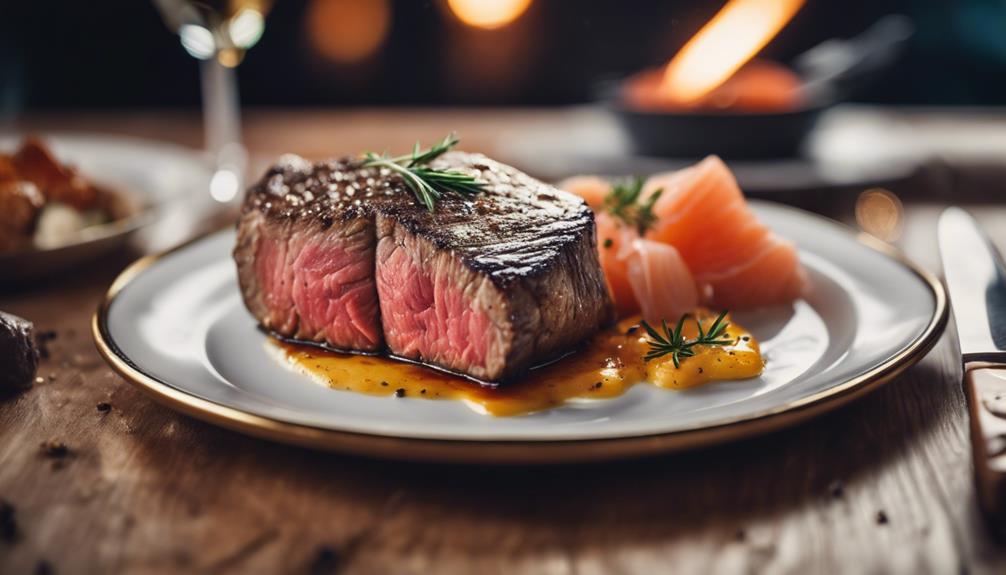
How can you elevate the flavors of various sous vide foods through the technique of searing? Searing plays an important role in enhancing the taste and appearance of different sous vide dishes. Here are three ways you can use searing to bring out the best in your sous vide creations:
- Sous Vide Meat Heats: For meats cooked sous vide, searing before or after can help develop a flavorful crust.
- High Smoke Point: Use oils with high smoke points like grapeseed or avocado oil for searing to avoid the burnt taste.
- Grill or Chimney: Opt for grilling or using a chimney starter for a smoky finish after sous vide to add depth to the flavor profile.
Searing for Enhanced Texture
Achieve a crispy texture on the exterior of your sous vide dishes by searing them after cooking. Searing after sous vide not only creates a visually appealing contrast between the tender inside and crunchy outside but also enhances the overall eating experience.
By mastering proper searing techniques, you can elevate the texture of your sous vide dishes to restaurant-quality standards. The crispy finish that searing imparts adds a satisfying crunch to meats and vegetables prepared using the sous vide method, making each bite more enjoyable.
Paying attention to achieving the right sear can make a significant difference in how your dish is perceived, both from a visual presentation and textural appeal standpoint. So, next time you cook sous vide, remember that searing isn't just a finishing touch but an essential technique for enhancing the texture of your dishes to impress your guests.
Searing Tips and Tricks
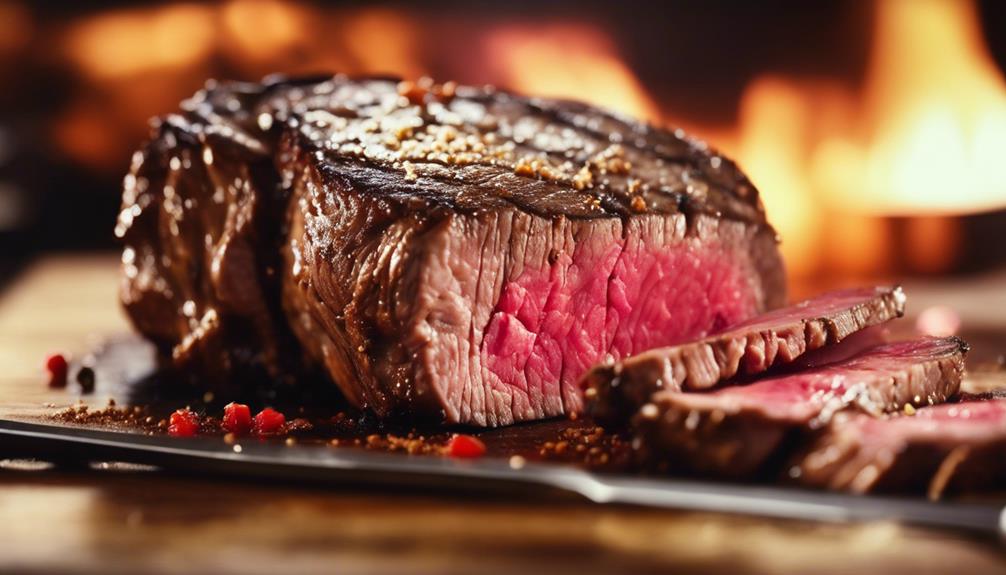
Searing your sous vide dishes can be greatly enhanced with some expert tips and tricks. Here are three essential pointers to help you perfect your searing technique:
- Pre-Searing: Jump-start flavor development and Maillard flavors by searing your meat before sous vide cooking. Pre-searing not only enhances crust development but also reduces the time needed for a final sear after your sous vide process.
- Temperature Gradient: Minimize the temperature gradient in your meat by pre-searing. This will lead to more consistent results and help in enhancing flavor penetration into the meat over long cooking times.
- Combining Techniques: For the best overall results in sous vide cooking, consider combining both pre-searing and post-searing techniques. This approach can help you achieve a perfect balance of flavors, textures, and consistent outcomes every time you cook sous vide.
Mastering these searing tips and tricks will elevate your dishes and impress your guests with delicious results.
Searing: Personal Preference or Necessity?
When deciding whether to sear your sous vide dishes, consider your personal preference and the desired outcome.
Searing is a choice that can enhance the flavor and texture of your dish, making it a necessity for some and a personal preference for others.
Some dishes truly shine with the addition of a crispy crust achieved through searing, while others may not require it.
Professional chefs often emphasize searing to elevate the presentation and taste of their sous vide creations, showcasing the importance of this step in the cooking process.
By understanding when to sear, you can optimize your sous vide experience, ensuring that each dish reaches its full potential.
Whether you prioritize flavor, texture, or presentation, the decision to sear your sous vide dishes ultimately depends on your personal preferences and the specific outcome you aim to achieve.
Experimenting With Searing in Sous Vide
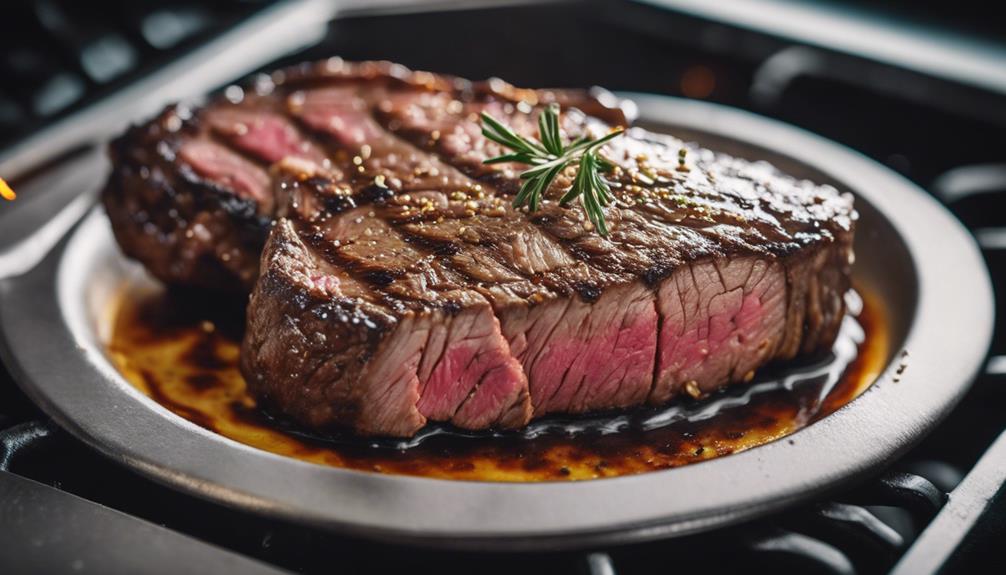
Considering the impact of searing on your sous vide dishes, diving into experimentation with different searing methods and timings can reveal new levels of flavor and texture for your culinary creations. Here are three key aspects to focus on when experimenting with searing in sous vide:
- Optimal Timing and Techniques: Explore how varying the searing time and methods can influence the texture and flavor of your sous vide dishes. Adjusting these variables can help you achieve the perfect balance for each ingredient.
- Pre-Searing vs. Post-Searing: Test out both pre-searing and post-searing techniques to determine which works best for different foods. This experimentation can lead to enhanced flavors and textures in your dishes.
- Utilizing Different Searing Tools: Experiment with various searing tools and equipment such as blowtorches, cast-iron pans, or grills to understand how they affect the searing process. The right tools can make a significant difference in achieving consistent and flavorful results.
Frequently Asked Questions
Do I Need to Sear After Sous Vide?
You should sear after sous vide for enhanced flavor, texture, and presentation. The Maillard reaction creates a delicious crust, caramelization benefits taste, and texture contrast elevates your dish. It's a time-saving option for versatile recipes, recommended by professional chefs.
Do You Need to Sear Fish After Sous Vide?
After sous vide, searing fish can enhance its appearance, texture, and flavor. It's a great way to elevate your dish by adding a crispy exterior to the tender interior. Consider searing to achieve those delicious results.
Do I Need to Sear Chicken After Sous Vide?
You should sear chicken after sous vide. Searing enhances flavor, creates a beautiful color, and adds a crispy texture. The Maillard reaction deepens taste, while caramelization benefits presentation. Searing locks in juices, improves taste, and elevates dining experience.
Is It Better to Sear First or Last?
When deciding whether to sear first or last, consider the searing techniques you prefer for flavor development and texture enhancement. Maillard reaction occurs with pre-searing, while post-searing preserves juiciness. Control temperature for best caramelization and crust formation.
Conclusion
To sum up, whether to sear or not to sear in sous vide ultimately comes down to personal preference.
While searing can enhance flavor and texture, it isn't always necessary.
Experiment with different techniques and see what works best for you and your taste buds.
Remember, the beauty of sous vide cooking is the ability to customize and perfect your dishes to your liking.
So go ahead, sear away or skip it – the choice is yours!
